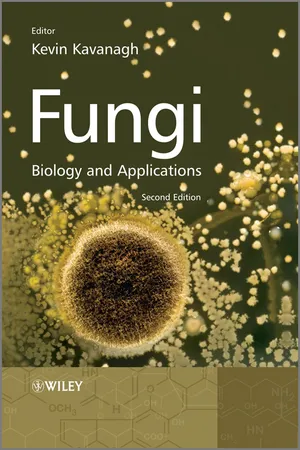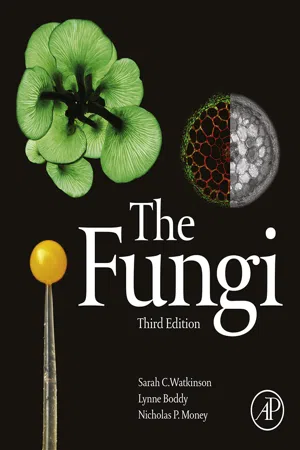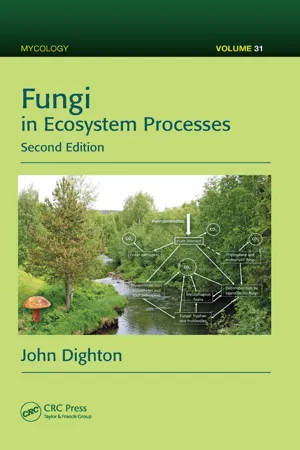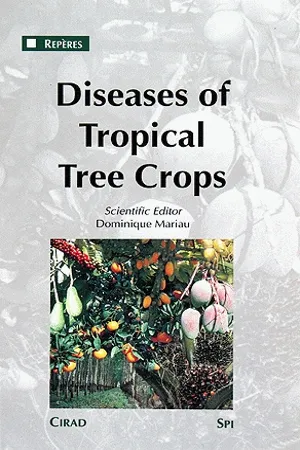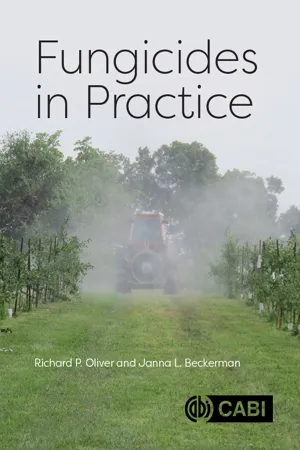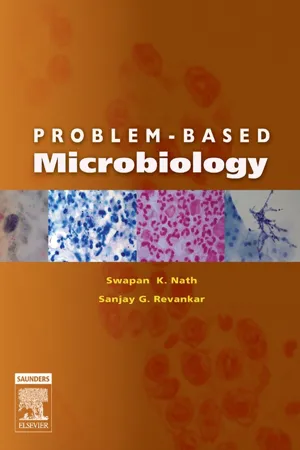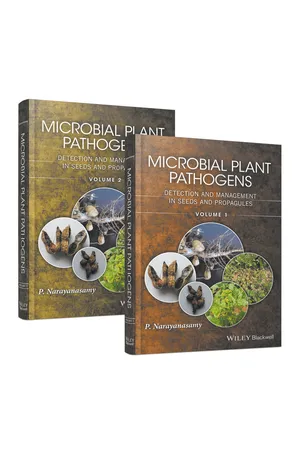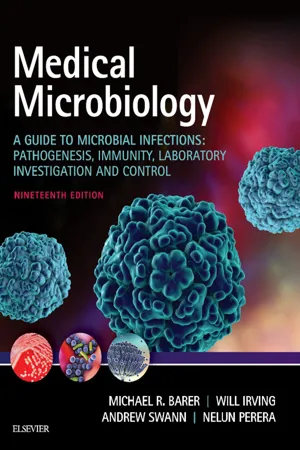Biological Sciences
Pathogenic Fungi
Pathogenic fungi are types of fungi that can cause diseases in humans, animals, and plants. They can infect their hosts through various means, such as through the air, soil, or direct contact. Pathogenic fungi can lead to a range of illnesses, from mild skin infections to serious systemic diseases, and they are a significant focus of research in medical and agricultural fields.
Written by Perlego with AI-assistance
10 Key excerpts on "Pathogenic Fungi"
- eBook - ePub
Fungi Bio-prospects in Sustainable Agriculture, Environment and Nano-technology
Volume 1: Fungal Diversity of Sustainable Agriculture
- Vijay Kumar Sharma, Maulin P. Shah, Shobhika Parmar, Ajay Kumar, Vijay Kumar Sharma, Maulin P. Shah, Shobhika Parmar, Ajay Kumar(Authors)
- 2020(Publication Date)
- Academic Press(Publisher)
Chapter 7PhytoPathogenic Fungi and their biocontrol applications
Indu Sharma* , Department of Biotechnology, Maharishi Markandeshwar Deemed to be University, Ambala, India *, Corresponding author. Email: [email protected]Abstract
Phytopathology is the scientific study of diseases in plants caused by pathogens (infectious organisms) and environmental conditions (physiological factors). Fungi are among the dominant causal agents of plant diseases. With respect to plant pathogens, fungi represent probably the most diverse group of ecologically and economically important threats. Most phytoPathogenic Fungi belong to the Ascomycetes and the Basidiomycetes. PhytoPathogenic Fungi use various strategies to colonize in plants and cause disease. PhytoPathogenic Fungi possess a wide range of enzymes destroying the carbohydrate polymers, which constitute the building materials of the cell walls. Some fungi kill their hosts and feed on dead material (necrotrophs), while others colonize the living tissue (biotrophs). For successful invasion of plant organs, Pathogenic Fungi developed strongly regulated and specialized infection structures. To further colonize hosts and establish disease, fungal pathogens organize a plethora of virulence factors and these interactions result in a broad spectrum of outcomes reaching from beneficial interactions to death of the host. Depending on the infection strategy, virulence factors perform different functions. While basically all pathogens interfere with primary plant defense, necrotrophs secrete toxins to kill plant tissue. In contrast, biotrophs utilize effector molecules to suppress plant cell death and manipulate plant metabolism in favor of the pathogen. Biological control of plant diseases with fungal pathogens has been considered a sustainable alternative method comparison to other chemical control. In plant pathology, the term biocontrol applies to the use of microbial antagonists to destroy diseases. Throughout their lifecycle, plants and pathogens interact with a wide variety of organisms. These interactions can expressively affect plant health in several ways. Different mode of actions of biocontrol-active microorganisms in controlling fungal plant diseases include soil amendments, hyperparasitism, entomogenous fungi, predation, antibiosis, cross protection, competition for site and nutrient and induced resistance. Successful application of biological control strategies requires more knowledge-intensive management. Commercial use and application of biological disease control have been slow mostly due to their variable performances under diverse environmental conditions in the field. To overcome this problem and in order to take the biocontrol technology to the field and expand the commercialization of biocontrol, it is important to develop new formulations of biocontrol microorganisms with higher degree of stability and survival. Future outlooks of biocontrol of plant diseases is bright and promising and with the growing demand for biocontrol products among the growers, mass production of biocontrol microorganisms and the use of biotechnology and nano-technology in improvement of biocontrol mechanisms, manage plant diseases, increase yield, protect the environment and biological resources and approach a sustainable agricultural. - eBook - ePub
Fungi
Biology and Applications
- Kevin Kavanagh(Author)
- 2011(Publication Date)
- Wiley(Publisher)
12 Fungal Pathogens of Plants Fiona Doohan 12.1 Fungal Pathogens of Plants A wide range of fungi cause diseases of plants (see Chapter 1 for a description of fungal taxonomy, morphology and reproduction). To be classified as a fungal plant pathogen or phytopathogen (phyto = plant), a fungus should, if possible, satisfy Koch's postulates or rules. Koch determined that an organism was the cause of an infectious disease if it can: (a) be isolated from a diseased host, (b) be cultured in the laboratory, (c) cause the same disease upon reintroduction into another host plant and (d) be re-isolated from that host. However, some fungal pathogens cannot be cultured or in some cases it is not easy to carry out Koch's tests. Since early in the nineteenth century, thousands of fungi have been recognized as parasites of plants and almost all plants are hosts to particular fungal diseases. Parasitism occurs where one species lives off another, as distinct from symbiosis, where different species live in harmony with each other and the relationship is mutually beneficial, or saprophytism, where organisms grow on dead organic matter. Plant-Pathogenic Fungi as classified as: Biotrophs: only grow and multiply when in contact with their host plants (and, therefore, cannot be cultured on nutrient media); for example, the fungi that cause rusts, powdery mildews and downy mildews. Non-obligate pathogens: grow and multiply on dead organic matter (and can, therefore, be cultured on nutrient media) as well as on living host tissue. These can be further distinguished as facultative saprophytes or facultative pathogens. Facultative saprophytes complete most of their life cycle as parasites, but under certain conditions they grow on dead organic matter - eBook - ePub
Fungi
Biology and Applications
- Kevin Kavanagh, Kevin Kavanagh(Authors)
- 2017(Publication Date)
- Wiley-Blackwell(Publisher)
14 Fungal Pathogens of Plants Fiona Doohan and Binbin Zhou 14.1 Introduction A wide range of fungi cause diseases of plants (see Chapter 1 for a description of fungal taxonomy, morphology, and reproduction). To be classified as a fungal plant pathogen or phytopathogen (phyto = plant), a fungus should, if possible, satisfy Koch’s postulates or rules. Koch determined that an organism was the cause of an infectious disease if it can: (1) be isolated from a diseased host, (2) be cultured in the laboratory, (3) cause the same disease upon re‐introduction into another host plant, and (4) be re‐isolated from that host. However, some fungal pathogens cannot be cultured, or in some cases it is not easy to carry out Koch’s tests. Since the early nineteenth century, thousands of fungi have been recognized as parasites of plants. Parasitism occurs where one species lives off another, as distinct from symbiosis where different species live in harmony with each other and the relationship is mutually beneficial, or saprophytism where organisms grow on dead organic matter. Plant‐Pathogenic Fungi are classified as: Biotrophs : only grow and multiply when in contact with their host plants (and therefore cannot be cultured on nutrient media); for example, the fungi that cause rusts, powdery mildews, and downy mildews. Non‐obligate pathogens : grow and multiply on dead organic matter (and can therefore be cultured on nutrient media) as well as on living host tissue. These can be further distinguished as facultative saprophytes or facultative pathogens. Facultative saprophytes complete most of their lifecycle as parasites, but under certain conditions they grow on dead organic matter - eBook - ePub
- Sarah C. Watkinson, Lynne Boddy, Nicholas Money(Authors)
- 2015(Publication Date)
- Academic Press(Publisher)
Phytophthora infestans (oomycete) (pp. 277–279). This led to death by starvation, of 1.5 million people, and emigration of over a million, largely to North America. The necessity to understand fungal diseases of plants is evident!In this chapter we will first consider the variety of fungi that causes diseases of plants and then the differences in susceptibility of plants to pathogens, and how plants defend themselves. We will next examine the main events in the disease cycle of pathogens, from arrival, attachment, and entry into the plant, through the different ways that pathogens establish in and exploit the plants, finally to exit of the pathogen from the plant, and survival until it finds another suitable host. These general concepts will be illustrated with case studies of a range of types of disease, mainly of crop plants. Of course, plants in natural environments also suffer from fungal diseases, as do other autotrophs such as lichens and seaweeds, and these are mentioned in separate sections. Finally we look at newly emerging diseases and the potential threats they pose to the security of our food supply.Spectrum of Interactions of Fungi with Plants
Fungi that attack living plants are called pathogens, or phytopathogens – to distinguish them from fungi that cause disease in other organisms. This is a catchall term that includes fungi that destroy living cells and feed on their contents, as well as fungi that absorb nutrients from living cells without killing them, but as a consequence, considerably reduce plant fitness. Plant pathologists commonly use the terms necrotrophs and biotrophs to describe these two categories of phytopathogen, respectively. The situation is complicated further by the fact that some fungi can initiate plant infection as biotrophs and switch later to the wholesale destruction of tissues as necrotrophs, a relationship termed hemi-biotrophic - eBook - ePub
- John Dighton(Author)
- 2018(Publication Date)
- CRC Press(Publisher)
CHAPTER 6 Fungi as Animal PathogensNegative Impacts on Faunal ProductivityIn addition to the positive effects of fungi on invertebrate and vertebrate animals, in terms of providing a consistent or intermittent food source, fungi can have detrimental effects on animal populations as pathogens. Within humans there are many fungal diseases that can be serious and fatal, especially to individuals with compromised immune systems. Details of some of the important human fungal pathogens can be seen in books such as those written by Blevins and Kern (1997) and Dismukes et al. (2003). However, a discussion of these pathogens is outside the scope of this book. Many of these diseases are not fatal on their own, but can exert enough influence on the health of their host to reduce growth and fecundity, which has consequential effects on the population of the animal.6.1 Entomopathogens
Such Pathogenic Fungi can have negative effects on insect populations. In her presidential address to the Mycological Society of America, Blackwell (1994) and the extensive review of entomopathogens provided by Vega et al. (2009) provide a background of the evolution of insect Pathogenic Fungi, such as the members of the Laboulbenales that are carried by and negatively affect many arthropods. Some of these fungi have been found useful for the biocontrol of important plant insect pests and other nuisance arthropods (Charnley, 1997; Leite et al., 2000; Freimoser et al., 2000). These fungi originated from saprotophs and biotrophs having an ability to penetrate invertebrate exoskeletons, or enter through the trachea, and able to breach the animal’s immune response (Charnley, 1997; Vega et al., 2009).Although there about 100 genera of fungi that have been identified as entomopathogens, only about four genera (Metarhizium, Bauvaria, Isaria, and Lecanicillium) have been commercially used on a regular basis, out of about 12 species of current commercial value (Vega et al., 2009). In commercial applications the fungus is dispersed as spores, often in an oil carrier that increases wetting of the insect cuticle to enhance spore germination and initial growth on the cuticle surface. The application of spores of Beauvaria bassiana in fallow fields reduced the population of grasshoppers by 60% and 33% within 9 and 15 days, respectively, after application (Johnson and Goettel, 1993). The incidence of fungal disease in the insects declined from 70%, 2 days after spore application, to 41% by 13 days and, subsequently, to 5% after 19 days. Similarly, the fungus, Metarhizium anisopliae has been used as a biocontrol agent against locusts under the trade name of Green Guard with a 90% efficiency of mortality under temperate and hot conditions (Figure 6.1 ), but lower kill rates under less favorable weather conditions (Miller and Hunter, 2001). The negative impact of Metarhizium on nontarget arthropods appears to be less significant than the pesticide fenitrothion (Table 6.1 - eBook - ePub
- Dominique Mariau, Dominique Mariau(Authors)
- 2001(Publication Date)
- Cirad(Publisher)
2 Pathogens Michel Dollet The indispensable phase of describing abnormal or decaying symptoms of cultivated plants is necessarily accompanied by an etiological investigation. The first step is to determine whether the origin of the anomaly is biotic or abiotic. This work deals only with abnormalities resulting from infections. This diagnosis is not always easy and requires the close collaboration of agronomists and plant pathologists. For this, the pathogen presumed to be infectious should not only be isolated, but its pathogenicity must also be proved by satisfying Koch’s postulates. Pathogenic Fungi were the first organisms to be recognized as responsible for causing diseases in plants. There are a large number of them causing diseases of leaves, roots and fruits, or systemic diseases leading to general decay. For a long time the identification of fungi was based on morphological criteria, which are found to be increasingly imperfect, finer criteria enabling a better separation of confused species: this is the case, for example, with two species of Phytophthora on cocoa, which are distinguished thanks to karyological observations. Physiological criteria and sexual compatibility have also helped to refine the distinction between fungal species. More recently, cellular and molecular biology techniques have become valuable tools for this identification - eBook - ePub
- Richard P. Oliver, Janna L Beckerman(Authors)
- 2022(Publication Date)
- CAB International(Publisher)
2
Plant Pathology and Plant Pathogens
Key Points
•What is a disease? •A diverse range of organisms causes diseases of plants.•Two types of pathogens dominate, the Oomycota and the Fungi; these are the targets of the great majority of fungicides.•Fungi are more related to animals and oomycetes are more related to plants than either is to the other. This is reflected in the different fungicides that control each group. •Pathogens are divided into biotrophs and necrotrophs and an intermediate class, hemibiotrophs. •Effectors are pathogen molecules that interact with plants and contribute to the disease phenotype. •Biotrophs and necrotrophs have different types of effectors and induce different plant responses.Introduction
Fungicides work by inhibiting the infection processes used by pathogens to cause disease or by enhancing the defensive capabilities of the plant. A very large range of organisms causes disease on plants but first we must define ‘disease’. We can operationally define disease as the ability of a pathogen to reduce the yield and/or the quality of a crop while growing and reproducing on the host plant. Pathogens are defined as organisms that cause disease. They are distinguished from saprobes and symbionts. Saprobes (previously saprophytes) are species that live off dead material and are ecologically limited to that role. Symbionts are organisms that grow on or in the plant and that are beneficial to its growth. This group includes the mycorrhizae, fungi that form close associations with roots and benefit the plant by making phosphate more available, and the rhizobia, bacteria which supply nitrogen to leguminous plants. We are also becoming much more aware of the vast complexity and abundance of microorganisms that associate with plants without causing substantial impacts. The microbiome of the plant, as this group is known, has only recently been studied in detail (Berendsen et al - eBook - ePub
- Swapan K. Nath, Sanjay G. Revankar(Authors)
- 2005(Publication Date)
- Saunders(Publisher)
Dimorphic fungi exist in nature as molds (infective form) and grow in the target tissue (e.g., lungs) of an infected host as yeast. The mold form also appears in cultures in the laboratory. Most dimorphic fungi that cause systemic infections have a characteristic endemicity in the geographic regions of the world. This habitat is the primary source of molds, where a human, as an incidental host, is exposed to conidia (spores) and fungal elements. The endemic fungal pathogens (e.g., Histoplasma capsulatum, Blastomyces dermatitidis, Coccidioides immitis, and Paracoccidioides braziliensis) that are capable of causing systemic mycoses are all dimorphic. Sporothrix schenckii is also a dimorphic fungal pathogen, but it causes localized subcutaneous mycosis rather than a systemic disease. The establishment of a mycosis usually depends on the size of the inoculum and on the host’s level of natural resistance to infection. Inhalation of airborne conidia (spores) is the common mode of transmission of mycoses, except in candidiasis, which is caused by endogenous mucosal colonization or overgrowth of Candida albicans, and in subcutaneous mycoses, which are caused by penetration of fungal conidia through a breach in the skin. In general, slow-growing fungi usually cause chronic infections in exposed at-risk individuals. Little is known about virulence factors and interactions between the host and the fungi. Adherence and invasion are dependent on the infecting species. Adhesins on fungi and lectin-like receptors on macrophages are involved in the colonization of lower respiratory airways. Pathogenic Fungi do not produce toxins, but they do show physiologic modifications during the invasion process. Most Pathogenic Fungi are also thermotolerant - eBook - ePub
Microbial Plant Pathogens
Detection and Management in Seeds and Propagules
- Perumal Narayanasamy(Author)
- 2016(Publication Date)
- Wiley(Publisher)
Table 4.1 ). Pathogenesis or the process of infection and disease development represents the dynamic interaction between the pathogen and host plant, depending on the levels of host plant resistance, pathogenic potential of the fungal isolates/strains, and the existing environmental factors. The different stages of pathogen invasion may be monitored and visualized by applying various techniques.Invasion paths of seedborne fungal pathogens.Table 4.1Fungal pathogen Plant tissue penetrated References A. Systemic infection through floral organs Diaporthe phaseolorum var. sojae From systemically infected mother plants to soybean seed Crittenden (1968) Fusarium moniliforme Maize seed Cordero et al. (1992) Fusarium oxysporum f.sp. lagenarium From vascular bundles of fruits of bottle gourd to tomato seed Kuniyasu and Kishi (1977) F. oxysporum f.sp. lycopersici From systemically infected mother plants to cotton seed Baker (1952) F. oxysporum f.sp. vasinfectum From systemically infected mother plants to pea seed Rudolph and Harrison (1945) F. oxysporum f.sp. pisi From systemically infected mother Plants to seed Baker (1952) Peronsopora parasitica Entry through hilar region from vascular tissues of infected radish; through stigma and ovary leading to embryonic infection Jang and Saffeulla (1990) Phytophthora capsici Oospores in seed embryos of squash; penetration through cuticle and integument stratum Melo et al. (1992) Plasmopara halstedii From systemically infected mother plants to sunflower seed Cohen and Sackston (1974) Verticillium dahliae From systemically infected mother plants to spinach sugar beet seed van der Spek (1972) B. Penetration through stigma Alternaria alternata Entry through style and ovary of pepper Lang (1917) Cercospora kikuchii Entry through hilar groove into the tracheids of soybean Sakai and Ogawa (1983) Colletotrichum capsici Entry through seed coat or remnant outer layer of endosperm of pepper Sangchote and Juangbhanich (1984) C. dematium - eBook - ePub
Medical Microbiology E-Book
A Guide to Microbial Infections
- Michael R. Barer, Will L Irving, Michael R. Barer, Will L Irving(Authors)
- 2018(Publication Date)
- Elsevier(Publisher)
- 2. Yeasts are predominantly unicellular and oval or round in shape. Most propagate by an asexual process called budding in which the cell develops a protuberance, which enlarges and eventually separates from the parent cell. Some yeasts produce chains of elongated cells (pseudohyphae) that resemble the hyphae of moulds; some species also produce true hyphae. A small number of yeasts reproduce by fission. Yeasts are neither a natural nor a formal taxonomic group, but are a growth form shown by a wide range of unrelated fungi.
- 3. Dimorphic fungi are capable of changing their growth to either a mycelial or yeast phase, depending on the growth conditions.
Historically, fungal classification has largely been based on their morphological characteristics, although physiological and biochemical tests have been important in yeast identification. Molecular sequence analysis has demonstrated that many of the phenotypic characteristics used to classify fungi do not predict phylogenetic relatedness, and its use has led to major changes in fungal classification and nomenclature. Many laboratories today employ DNA sequencing as part of their routine protocol for fungal identification.Fungal diseases of humans
Fungal pathogens
There are at least 100,000 named species of fungi. However, <1000 have been recognised to cause disease (mycosis) in humans or animals. Most are moulds, but there are a number of pathogenic yeasts, and some are dimorphic. Dimorphic fungi usually change from a multicellular mould form in the natural environment to a budding single-celled yeast form when causing infection. In the laboratory the tissue form can be induced by culture at 37°C on rich media such as blood agar, whereas the mould form develops when incubated at a lower temperature (25–30°C) on a less rich medium such as Sabouraud dextrose agar.Some fungi, such as the systemic pathogens Histoplasma capsulatum and Blastomyces dermatitidis , can establish an infection in all exposed individuals. Others, such as Candida and Aspergillus
Index pages curate the most relevant extracts from our library of academic textbooks. They’ve been created using an in-house natural language model (NLM), each adding context and meaning to key research topics.
Explore more topic indexes
Explore more topic indexes
1 of 6
Explore more topic indexes
1 of 4

